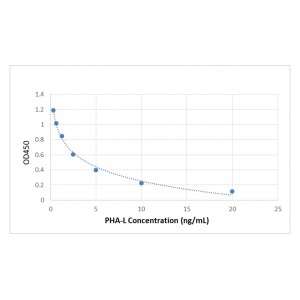 View larger
View larger
Phaseolus vulgaris agglutinin,PHA-L ELISA Kit
NB-E90041L
Phaseolus vulgaris agglutinin,PHA ELISA Kit For research use only. Not for use in diagnostic procedures.For general protocol and instruction, please click the following links:Quantitative Elisa Kit InstructionSandwich ELISA kit general instruction
Data sheet
| Background | Phytohaemagglutinin (PHA, or phytohemagglutinin) is a lectin found in plants,especiallycertain legumes. PHA actually consists of two closely related proteins, called leucoagglutinin (PHA-L, UniProt ID, P05087) and PHA-E (UniProt ID P05088). The letters E and L indicate these proteins agglutinate erythrocytes (red blood cells) and leukocytes (white blood cells) respectively. Phytohaemagglutinin has carbohydrate-binding specificity for a complex oligosaccharide containing galactose, N-acetylglucosamine, and mannose. In medicine these proteins are useful and are used as a mitogen to trigger T-lymphocyte cell division and to activate latent HIV-1 from human peripheral lymphocytes. In neuroscience, anterograde tracing is a research method that uses the protein product phytohaemagglutinin PHA-L as a molecular tracer that can be taken up by the cell and transported across the synapse into the next cell thereby tracing the path of axonal projections and relative connections that nerve impulses travel beginning with the source located at the perikaryon (cell body or soma) and through the presynaptic part located on neuron's efferent axon all the way to the point of termination at the efferent synapse which then provides input to another neuron. Lymphocytes cultured with phytohaemagglutinin can be used for karyotype analysis. Stimulation of peripheral blood lymphocytes by phytohaemagglutinin presents a classic model of transition of cells from the quiescent G0 phase of the cell cycle into G1-, and subsequently progression through S-, G2- and M- phases of the cycle. |
| Assay Range | 0.312 ng/ml - 20 ng/ml |
| UniProt ID | P05087 |
More info
Phaseolus vulgaris agglutinin,PHA ELISA KiT
For protocols and availability questions, please fill out our contact us form and make sure to include your company name, business email, and phone number. We will contact you within 24 hours.
Different lot may vary, please follow the instruction coming with the kit.

